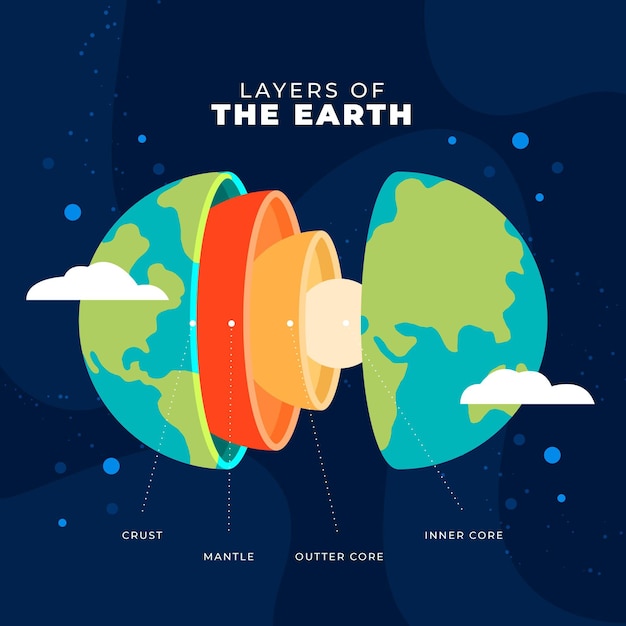

The Earth is the only known planet in the universe to support life.
The Earth has approximately 12,000 species of ants.
Earth is home to the largest living structure, the Great Barrier Reef.
The Earth’s atmosphere is composed of 78% nitrogen, 21% oxygen, and trace amounts of other gases.
The Earth’s rotation is gradually slowing down at a rate of about 1.7 milliseconds per century.
Earth’s highest point is Mount Everest, standing at 29,029 feet (8,848 meters) above sea level.
The Earth is about 4.5 billion years old, but life only started to emerge around 3.5 billion years ago.
The Earth’s surface consists of 71% water and 29% land.
Earth is the third planet from the Sun in our solar system.
The Earth’s magnetic field protects us from harmful solar wind and cosmic rays.
The deepest spot on Earth, the Challenger Deep in the Mariana Trench, is over 36,000 feet (10,972 meters) deep.
The Earth orbits the Sun at an average distance of about 93 million miles (150 million kilometers).
The Earth experiences four seasons due to its tilted axis in relation to its orbit around the Sun.
Earth is the only planet in the solar system known to have plate tectonics.
The Earth’s largest desert is the Antarctic Desert, covering an area of about 5.5 million square miles (14.2 million square kilometers).
The Earth’s ozone layer protects us from harmful ultraviolet (UV) radiation.
Earth has over 1.5 million species of fungi.
The longest mountain range on Earth is the Mid-Atlantic Ridge, stretching approximately 10,000 miles (16,000 kilometers).
The Earth’s deepest lake is Lake Baikal in Russia, reaching a depth of over 5,387 feet (1,642 meters).
The Earth’s tallest waterfall is Angel Falls in Venezuela, which drops approximately 3,212 feet (979 meters).
Earth is the densest planet in our solar system.
The Earth’s atmosphere becomes thinner as you go higher in altitude, making it harder to breathe at high elevations.
The Earth’s magnetic poles are not aligned with the geographic poles.
The Earth’s largest canyon is the Grand Canyon in Arizona, USA.
Approximately 70% of the Earth’s surface is covered in oceans.
Earth’s largest island is Greenland, with an area of about 836,300 square miles (2.17 million square kilometers).
The Earth’s rotation causes the phenomenon of day and night.
Earth’s highest waterfall on land is Tugela Falls in South Africa, dropping 3,110 feet (948 meters).
The Earth’s core is primarily composed of iron and nickel.
The Earth’s second highest mountain is K2 in the Karakoram range, standing at 28,251 feet (8,611 meters).
Earth has approximately 44,000 species of spiders.
The Earth’s moon is the fifth-largest moon in the solar system.
The Earth’s surface temperature has been gradually increasing due to human activities.
Earth’s largest hot desert is the Sahara Desert, covering an area of about 3.6 million square miles (9.4 million square kilometers).
The Earth’s rotation is slightly faster at the equator than at the poles.
Earth’s largest carnivorous dinosaur was the Spinosaurus, measuring up to 59 feet (18 meters) long.
The Earth’s largest man-made structure is the Great Wall of China, stretching approximately 13,171 miles (21,196 kilometers).
Earth’s largest living land animal is the African elephant, weighing up to 12,000 pounds (5,400 kilograms).
The Earth’s atmosphere is divided into different layers, including the troposphere, stratosphere, mesosphere, thermosphere, and exosphere.
Earth’s tallest animal is the giraffe, with males reaching heights of up to 18 feet (5.5 meters).
The Earth’s largest flying bird is the wandering albatross, with a wingspan of up to 11 feet (3.4 meters).
Earth’s largest herbivorous dinosaur was the Argentinosaurus, measuring up to 100 feet (30 meters) long.
The Earth’s surface is constantly changing due to erosion, volcanic activity, and tectonic movements.
Earth’s largest reptile is the saltwater crocodile, reaching lengths of up to 23 feet (7 meters).
The Earth’s largest organ is the skin, which covers an average area of 20 square feet (1.9 square meters) for an adult human.
Around the world, coffee enthusiasts enjoy Monin coffee concentrate since it is a multipurpose product. Conveniently combining…
The Importance of Choosing the Right Shower for Your Bathroom Renovating your bathroom can be…
Usain Bolt holds the record for the fastest 100-meter sprint in history.Bolt was named Sportsman…
Love is in the air... and it smells suspiciously like chocolate!Roses are red, violets are…
Life's a beach, take a picture and relax.Sun, sand, and salty kisses. That's what beach…
Hungary is home to the largest thermal water cave system in the world.The Rubik's Cube…